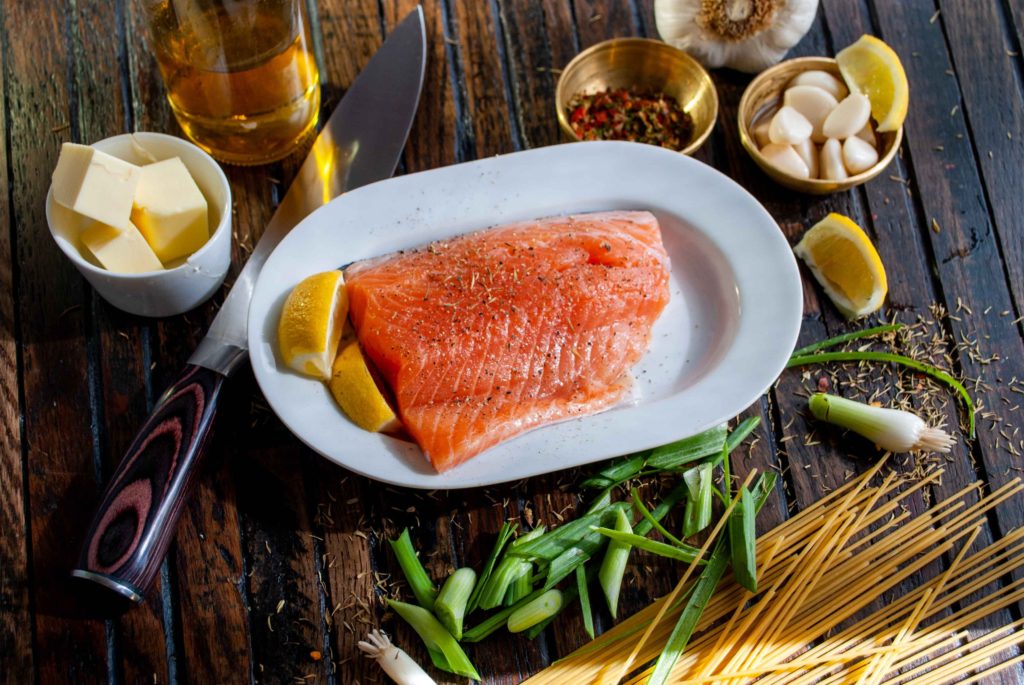How to Calculate Your Macros for Fat Loss

If you haven’t read my post on finding your starting calorie intake for fat loss, check that one out too. The link is below.
How Many Calories Should I Eat to Lose Weight?
People often get so caught up in calculating their macros for fat loss and make it way more complicated than it needs to be. There is no perfect macronutrient distribution, and there’s a range for each macronutrient that can work great for you.
Besides, you’re going to have to adjust your calories and macros anyways as you diet and get leaner due to metabolic adaptation. The amount of calories, protein, carbs, and fats that you started with at the beginning of your fat loss phase won’t be the same as what you end with.
Here’s a simple step-by-step breakdown of how you can set your macros, and how you adjust them as you progress through your fat loss phase.
Table of Contents
Protein
Protein intake should be 0.8-1.2 grams of protein per pound of body weight, or goal body weight if you’re over about 20% body fat for men, and 28% for women.
In most cases, I suggest 1 gram of protein per pound of body weight or goal body weight. No calculations required, very easy to remember.
Protein intake can get as high as 1.5 grams per pound of body weight for men that get below 8% body fat, and women that get below 16% body fat.
Hunger and the risk of muscle loss become higher the leaner someone gets. Keeping protein intake very high can help prevent or reduce both of those. Maintaining muscle is key for both improving your body composition, and minimizing the effects of metabolic adaptation. Protein intake is often higher during fat loss phase than a muscle building phase.
Also, protein is more satiating than most carbohydrates and fats, so it will keep you satisfied and full for longer between meals. It also has a higher thermic effect of food (TEF), meaning your body burns more calories digesting and absorbing protein, than it does carbs and fats. The thermic effect of food (TEF) makes up approximately 10% of your TDEE (Total Daily Energy Expenditure).
When in doubt, have more protein.
Fats & Carbohydrates
You’ll want 20-35% of your calories to come from dietary fat. I wouldn’t recommend letting fats go below 0.3 grams per pound of body weight.
After you’ve set your fats, the remainder of your calories will come from carbohydrates.
As you can see, the range for fats is fairly large, 20-35% of your calories.
Fats and carbs have an inverse relationship. The higher your fats are, the lower your carbs will be. The lower yours fats are, the higher your carbs will be.
Some people prefer higher fat foods. They enjoy those foods more and they feel better with a low-carb, high-fat approach. If they aren’t as active and don’t have any intense training to fuel and recover from, this could be a great choice.
Others rather have more carbs. They enjoy high-carb foods more than they do high-fat foods. If they’re very active, doing a lot of intense lifting, and their goal is to maximize muscle retention while losing fat to improve their body composition, a higher carb approach would most likely be better. The carbs will be beneficial for fueling and recovering from weight training, and will help hold onto muscle as they drop fat. Carbs are protein sparing, which means glycogen will be used for energy instead of breaking down muscle tissue. Lots of good reasons to have enough carbs in your diet when the goal is to build a lean, muscular physique.
When setting your macros, it’s important to consider your goals, activity level, health, and what is sustainable and works well for you.
If your goal is to build muscle, hold onto muscle as you drop body fat, and improve your physique, I’d recommend starting your fat loss plan with a lower fat intake, around 20-25% of your calories coming from fat, and have your carbs higher.
But not everyone does well with a higher carb approach. Others do better with higher fats, or a moderate amount of each. That’s part of the fun in this. You get to experiment with yourself and find what works great for you.
Although one approach may appear optimal on paper, it won’t be optimal for everyone when it comes time to apply it in real life.
To recap what we talked about above.
- Protein:
- 0.8-1.2 grams per pound of body weight, or goal body weight. Increase protein intake as you get leaner if it’s not already high.
- If you get to 8% body fat (16% for women) and below, you could benefit from having protein intake at 1.2-1.5 grams per pound of body weight.
- Fats:
- 20-35% of your calories. Don’t go below 0.3 grams per pound of body weight.
- Carbs:
- Remaining calories come from carbs.
Example: Calculating Macros and Adjusting
Let’s say this persons starting calorie intake for their fat loss phase is 2,800 calories, and they weigh 200 pounds at roughly 14% body fat
Protein (4 calories per gram)
- We’ll make it easy and say 1 gram per pound of body weight, so 200 grams of protein
- 200 grams of protein x 4 calories per gram = 800 calories from protein
Fats (9 calories per gram)
- We’ll set fats to 25% of their calories
- 2,800 x 0.25 = 700 calories from fat
- 700 calories/9 calories per gram = 77.78 grams of fat
- We’ll round that to 75 grams of fat
Carbs (4 calories per gram)
- 800 calories from protein + 700 calories from fat = 1,500 calories
- 2,800 total calories – 1,500 calories = 1,300 calories remaining
- 1,300 calories/4 calories per gram = 325 grams of carbs
Final Macros
- 200 grams of protein
- 75 grams of fat
- 325 grams of carbohydrates
- 2,800 calories
Let’s say this person drops 4% body fat and 8 pounds, and is now down to 192 pounds at 8% body fat. Calories have dropped to 2,600.
Protein
Since he’s getting leaner, we’ll increase protein to 1.15 grams per pound of body weight.
- 192 pounds x 1.15 grams per pound = 220 grams of protein
- 220 grams of protein x 4 calories per gram = 880 calories from protein
Fats
- We’ll keep fat at 25% of total calories
- 2,600 x 0.25 = 650 calories from fat
- 650 calories/9 calories per gram = 72.22 grams of fat
- We’ll round that to 70 grams of fat
Carbs
- 880 calories from protein + 650 calories from fat = 1,530 calories
- 2,600 total calories – 1,530 calories = 1,070 calories remaining
- 1,070 calories/4 calories per gram = 267.5 grams of carbs
- We’ll round that to 265 grams of carbs
Adjusted Macros
- 220 grams of protein
- 70 grams of fat
- 265 grams of carbs
Instead of taking your new calorie intake and doing the calculations again, you can also adjust your macros to hit your new calorie intake.
And there you have it. Don’t worry about finding the perfect macro split. It doesn’t exist, and you’ll be searching forever. There’s a range for each macronutrient that can work for you, not an exact number that must be hit.
Choose a reasonable macro split and give it a shot. That’s the only way to know for certain what works, what doesn’t, and what the outcome will be.
Be aware of how your body responds to different approaches to nutrition so you can take note of what works, and do more of what works.
Keep in mind that as you lose fat and get leaner, your bodies energy requirements will change. So your calories and macros will need some adjusting as your progress through your fat loss phase.
If you ever have any questions, drop a comment below, or you can message me on Instagram HERE.
Could you use some help putting your fat loss plan put together and making the proper adjustments as go through the dieting process? Fill out the form below and I’ll get back to you as soon as I can with the next steps.
